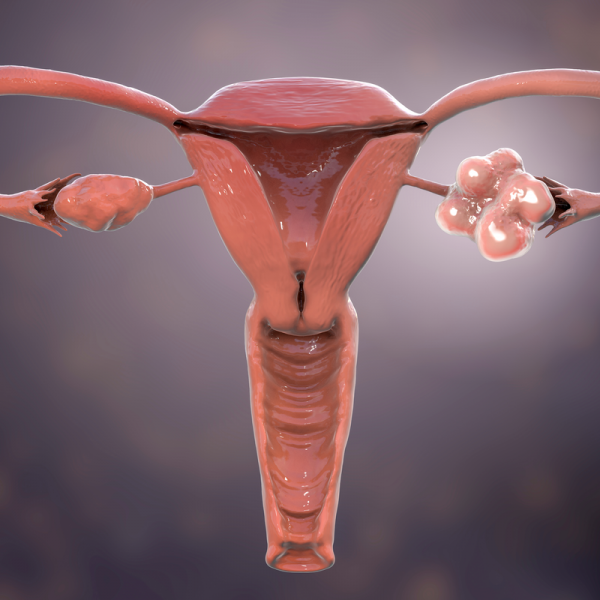
What is a Krukenberg tumour?
A Krukenberg tumour is the name given to a metastasis of a carcinoma of the gastrointestinal tract in the ovaries (ovary) or in the Douglas space (an outpouching of the peritoneum). It is named after the first person to describe this disease, Friedrich Ernst Krukenberg. Krukenberg's tumour accounts for about 14 per cent of all ovarian metastases and is thus the third most common type of tumour of the ovaries. Women in middle age, who are either in the perimenopause or in the postmenopause, develop a Krukenberg tumour with above-average frequency.
How does a Krukenberg tumour develop?
The exact cause of a Krukenberg tumour is still unknown. However, doctors assume that the metastases either spread through the blood (haematogenous) or that the tumour cells migrate directly in the abdominal cavity and from here also reach the ovaries. Doctors refer to this as "drip metastasis". However, the latter theory is contradicted by the fact that the omentum majus, which is located between the stomach and the ovaries, is not affected by metastases. Moreover, Krukenberg tumours occur in the ovarian stroma, i.e. inside the ovary and not outside.
Where is the primary tumour found in Krukenberg tumours?
The majority of all Krukenberg tumours are caused by stomach cancer. According to a study in the "Journal of Medical Case Reports", about 76 percent of all Krukenberg tumours are due to stomach cancer. This is followed by colon cancer with 11 percent, breast cancer with 4 percent and appendix cancer with 3 percent. In rather rare cases, Krukenberg tumours originate from a primary tumour in other organs, such as the gallbladder and/or the pancreas.
What symptoms does a Krukenberg tumour cause?
In many cases, the symptoms of a Krukenberg tumour are rather unspecific and therefore often cannot provide any conclusion about the disease. Many people complain of pain in the abdomen, i.e. in the lower abdomen. In addition, the following other complaints may occur:
- vaginal bleeding,
- Pain during sexual intercourse (dyspareunia),> pain in the lower abdomen and/or pelvis
- Pain in the lower abdomen and/or pelvis,
- Changes in the menstrual cycle,
- Bloating and/or flatulence
- Loss of performance
- excessive hair growth where women tend to grow little hair, such as on the face, chest or back,
- low red blood cell count (anaemia),
- Abdominal mass, which can be felt under the skin
In an advanced stage, fever, night sweats and unwanted weight loss may also occur.
How is a Krukenberg tumour diagnosed?
In some cases, it is possible to diagnose a Krukenberg tumour by palpating the lower abdomen. As a rule, however, the diagnosis is made by the usual imaging methods, such as an ultrasound examination, a computer tomography (CT) or magnetic resonance imaging (MRI). A laparotomy is also possible. This involves surgically opening the abdominal cavity to check whether an organ is diseased or injured. Generally, the diagnosis of a Kruenberg tumour can be made either before or after the diagnosis of the primary cancer.
If a Kruenberg tumour is suspected in the ovaries, either an ultrasound scan or a computerised tomography (CT) scan may reveal it. If a tumour is diagnosed, samples can be taken from it and examined in a laboratory (biopsy). The tissue sample can be taken surgically or by needle biopsy. A biopsy provides information about the type of tumour and is essential for choosing the right treatment method.
In addition to imaging and a biopsy, blood tests can also provide information about the presence of a Krukenberg tumour. If an elevated CA-125 level is detected by a blood test, this could be an indication that a malignant ovarian tumour is present. Especially in patients with gastrointestinal cancer, a blood test is usually done to check whether a Krukenberg tumour is also present. Blood tests can also tell how much a patient recovers after a Krukenberg tumour has been surgically removed.
How is a Krukenberg tumour treated?
A Krukenberg tumour is a metastasis, i.e. a secondary tumour. It is extremely important for the treatment to find and treat the primary tumour. However, this can be difficult in many cases because the primary tumour can be very small. In many cases, the main primary tumour, such as breast or stomach cancer, can remain for a long time and spread to the ovaries until it is detected.
Generally, neoadjuvant chemotherapy or radiotherapy are considered as therapeutic procedures to reduce the size of the tumour before surgical removal. If the tumour is large enough, the ovaries and the affected parts of the intestine are removed. Chemotherapy can also be administered after surgery to limit the growth of any remaining tumour cells or to destroy them.
In other cases of the disease, palliative therapies can also be carried out , which aim to relieve the symptoms and improve the cancer patient's quality of life.
What is the prognosis for a Krukenberg tumour?
The prognosis for a Krukenberg tumour is much better if only the ovaries or pelvis are affected. If the tumour has spread very far, the prognosis is rather unfavourable.
In general, however, the mortality rate for patients with a Krukenberg tumour is rather high. According to a study in "Cancer Management and Research", the average survival time for a Krukenberg tumour is about 14 months. The prognosis is similarly poor according to research results from the "Archives of Pathology & Laboratory Medicine". They indicate that most patients with a Krukenberg tumour are alive less than two years after their diagnosis.
